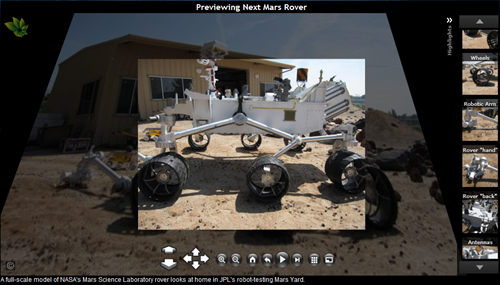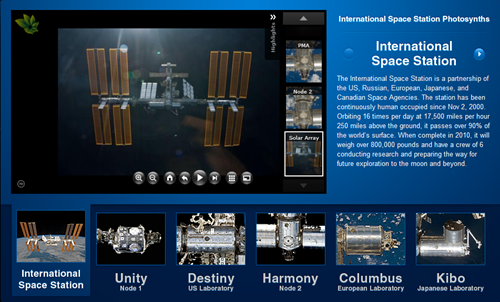Photosynth switches to Silverlight, commercializes and integrates into Virtual Earth, while NASA, meanwhile, shows the ISS
Content
- Photosynth is switching to Silverlight. Step back two forward
- Photosynth commercializes and integrates into Virtual Earth
- NASA Demonstrates ISS and Mars-Rover Photos through Photosynth
Photosynth is switching to Silverlight. Step back, two forward.
Photosynth is getting closer to people - Silverlight-player is becoming the main - cross-platform comes to the fore.
The DirectX player remains, but becomes secondary (there is a corresponding link under the synth viewer).

Using a Silverligh player (compared to DirectX) may seem like a step backward in terms of performance, rendering speed, and frame rate. However, developers are actively working on this problem, but the advantages are obvious.
The first step forward is the availability of the player to non-win-users. Of course, this is a very important step, I think not Windows users will be happy.
In addition, if you need to insert a player on your page, now it is the silverlight player that is used, which is also a plus.
By the way, the player interface is also slightly updated, as can be seen in the screenshot above. The developers took into account the wishes of users and placed the controls at the bottom center.
The second step forward is the new Synth Highlights functionality , which allows you to select some of the best among the entire volume of photos that you took to make synth.
Selected photos are displayed in a list of previews in the panel to the right of the viewport.
To edit, select the option Edit Synth and Highlights . The syntax editing mode will open (by the way, note that this is a Silverlight application):

To mark a photo, select it in the player (in 3d or 2d mode), click Add Highlight, enter a title and caption for the image. If there are several marked photos, you can change their order.
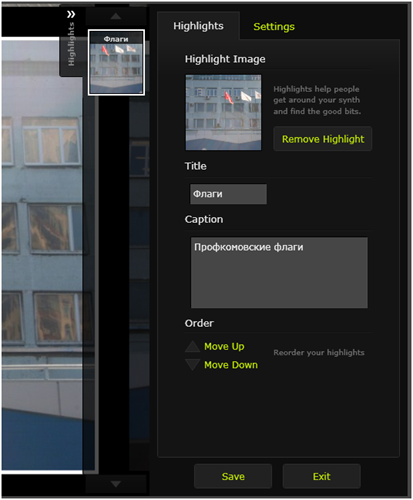
After saving, the marked photos will be available in the Highlights panel.
I would also like to note the fact that the transition from one photo to another is animated, that is, the player moves the camera along a certain path, and not just jumps. Try it yourself .
Photosynth commercializes and integrates into Virtual Earth
As you know, a few months ago, the team doing Photosynth joined the Virtual Earth team. This was a natural movement towards giving the Sintes a geographic location on the one hand and giving the maps additional interactive content on the other.
The baseline synth binding to the Virtual Earth map was already in October; when editing the syntax parameters, you can specify it directly on the map where the syntax was taken.
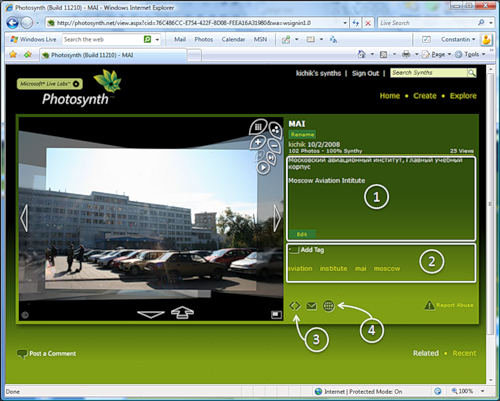
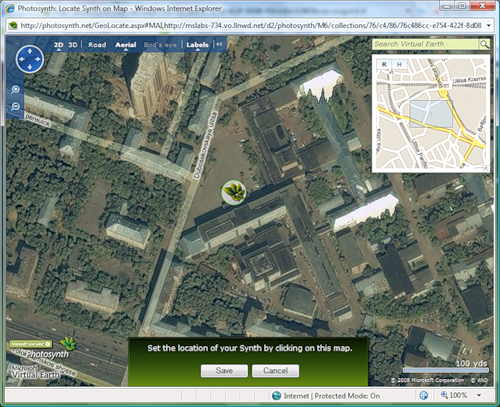
If such a geographical reference is indicated, you can simply go into the synth and see where it was taken.
Then the syntheses were integrated into Virtual Earth in a separate layer, and on the Photosynth.net website itself a map of all photosynthes appeared .

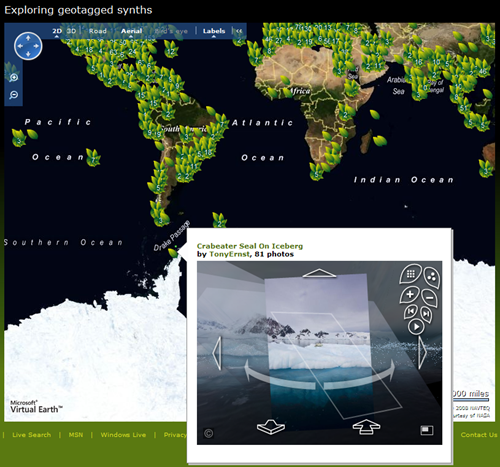
Finally, now for commercial use Virtual Earth and Photosyntha special licensing program has been launched .
According to Jeff Kelisky, general manager of the Mapping and Local Search group at Microsoft,
The integration of Photosynth into Virtual Earth is an important step towards enabling businesses to use Photosynth in the most relevant and user-friendly way. Thanks to the integration capabilities and the recently added Silverlight API, our Virtual Earth partners get their hands on great tools for creating, distributing, demonstrating and embedding synths across a wide variety of platforms and solutions and for building attractive user behavior patterns.Possible examples of using a new commercial offer:
- The property. Demonstration to potential buyers of the external and internal appearance of objects of sale.
- Tourism, holiday homes. Demonstration of 3D panoramas of hotels, hotels, pensions, attractions, views of the city, resort, etc.
- Retail. Demonstration to customers of the appearance of shops, counters, shelves with products and individual products.
- Cultural and state projects. Providing citizens with visual information about services, buildings, sites, territories, etc.
- Media and entertainment. Using the new multimedia space in a variety of projects.
- Internal use. Non-public synths can be used to demonstrate internal geographically attached information.
NASA Demonstrates ISS and Mars-Rover Photos through Photosynth
According to the Silverlight team’s blog , NASA has made public a series of photos of the International Space Station (ISS) and the MARS Rover science lab in field trials as part of its educational programs .
Mars Rover International Space Station and individual modules It is a pity that there are no syntheses of Russian modules, all somehow Japanese, American, and European.
